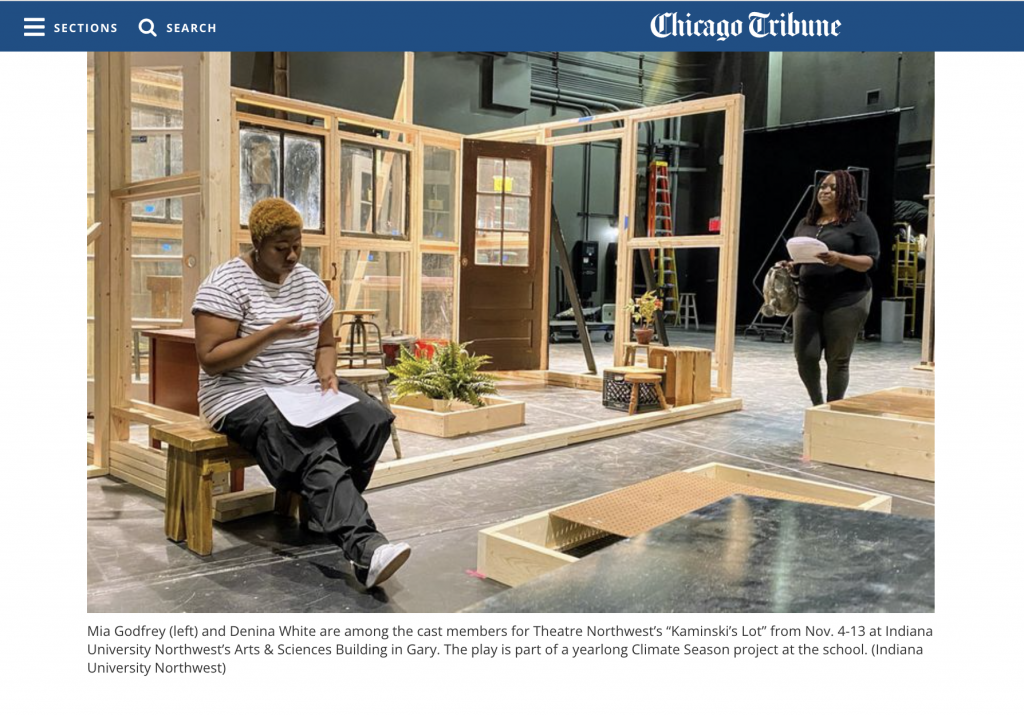Climate change, environmental justice take center stage in Theatre Northwest’s ‘Kaminski’s Lot’
By JESSI VIRTUSIOPOST-TRIBUNE |OCT 29, 2021 AT 3:16 PM

Mia Godfrey (left) and Denina White are among the cast members for Theatre Northwest’s “Kaminski’s Lot” from Nov. 4-13 at Indiana University Northwest’s Arts & Sciences Building in Gary. The play is part of a yearlong Climate Season project at the school. (Indiana University Northwest)
Indiana University Northwest in Gary is in the midst of a yearlong Climate Season project, which is described as “combining the arts, climate change awareness and campus-community outreach and engagement.”
Jeff Biggers, whom Indiana University Northwest School of the Arts invited to serve as Climate Narrative Playwright-in-Residence, was commissioned to write the play “Kaminski’s Lot.”
“This was an extraordinary opportunity to bring the climate crisis to the stage,” said Biggers, an author, journalist, historian and playwright who lives in Iowa.
“They’re really one of the first campuses to hire a playwright-in-residence to deal with climate change. What I’ve been impressed with is the level of professionalism and the real commitment they have to doing it right."
“I don’t think I’ve ever been involved in a theatre production where there’s been so much community-campus involvement.”
Mark Baer, associate professor of theater at Indiana University Northwest, directs “Kaminski’s Lot,” which Theatre Northwest stages Nov. 4-13 at the school’s Arts & Sciences Building.
“The play is based on a broad range of interviews, oral histories and field research with Indiana University Northwest students and faculty and also community members in Gary so it’s heavy on this campus-community cooperation,” Biggers said.
“One of the mandates when they brought me on to work on the play was: How do we use our own pool of resources, stories, histories and research to tell a better story to really bring the climate crisis home and put it on stage.
“Climate crisis is happening now. We can’t simply put our heads in the sand anymore. We have to figure out how we’re going to deal with it, move on and change our communities.”
Writing “Kaminski’s Lot” fit in with Biggers’ work, which has included the Climate Narrative Project he founded in 2013 and is described as seeking, in part, “to train a new generation of ‘climate storytellers’ and climate leaders.”
“We have a vanload of Indiana University Northwest students and faculty who are returning from a field trip to the Dunes for research who are caught up in a massive storm like a derecho and have to find refuge in Gary in what they think is an abandoned lot but, in fact, is a thriving urban farm,” Biggers said.
“That becomes the focal point of our drama and our comedy.”
The cast of “Kaminski’s Lot” includes Joseph Bugajski, Shallon Farmer, Mia Godfrey, Jasmine Jaramillo, Tyler Marrie, Emma Ton and Denina White.
“What’s unique with this production is the actors have agreed to do additional training in the field, which means they’ve visited a lot of places we’ve talked about,” said Biggers, who worked with the actors during a September rehearsal for the show.
“They’ve gone to urban farms, met urban farmers, gone out to the Dunes. They’ve done historical field trips through Gary. They met with community activists, historians and environmentalists.
“The actors have really gone beyond the call of duty in terms of not just taking on an original play but also trying to understand it right there in the community itself.”
The production team for “Kaminski’s Lot” includes set designer Katherine Arfken.
“The set design is quite unique because they’re following low-carbon principles, using recycled materials, for example. They’re trying to walk the walk onstage and really do it right,” said Biggers, who has worked as a writer, performer and educator in Europe, India, Mexico and the United States.
“The director is excellent. We’ve been working on this for months to really understand the complexities of these climate issues and make it real. If anything, ‘Kaminski’s Lot’ is about rediscovering our sense of community, our sense of place and our sense of history in a time of climate crisis.”
“Kaminski’s Lot” is one of several Climate Season events including Resilient Midtown Tour, which was on Sept. 25 at Stewart House Urban Farm and Gardens in Gary, and the upcoming Fall MicroPlay Workshop, MicroPlay Festival from March 31-April 9 and Performing Arts Student Capstone Production in spring.
A collaboration with the Calumet Artist Residency, the Climate Season project is described as an effort to “address a global call for climate education and action through a series of theater and community events, combining a multidisciplinary collaboration between the sciences, humanities and the arts.”
